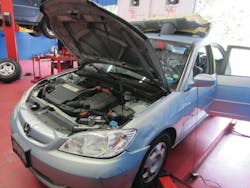CUSTOMER CONCERN:
IMA light with code 78.
VEHICLE APPLICATION:
2005 Honda Civic Hybrid 1.3L
REPORTED VEHICLE MILEAGE:
152,104 miles
Tests/Procedures:
- Scan for codes and check to see if there is also a P1586.
- If not, clear the code and then run the vehicle at 3,500 to 4,000 rpm.
- If P1586 does not set, check HV battery module's calibration ID.
- If the calibration ID does not match what is specified in TSB A12010, reflash the module.
TOOLS USED:
- Scan tool
- Information system
- CAT III multimeter
- Insulation tester
- High voltage safety equipment
If a vehicle with a check engine light rolls into your bay, what is your diagnostic routine?
First you may scan the code, check technical service bulletings (TSBs) and do a visual inspection of the vehicle and then follow the test plan offered by your scan tool or information system to diagnose the vehicle. Throughout the whole process, your particular experience with the problem and with vehicles in general informs you when to conduct certain tests with particular tools and when to disregard the test plan if necessary.
Does any of this change when we have a different light on, like an airbag or ABS light? Of course not! So, don't get intimidated if you ever come across a Honda hybrid vehicle that has an integrated motor assist (IMA) light on. Your instincts won't fail you.
Code 78: Battery Module Deterioration
So, a 2005 Honda Civic Hybrid rolls into your door. It has over 150,000 miles on it and that means Honda no longer has any liability if the HV battery dies. Now the customer brings it to you because the IMA light is on. (Fig. 1)
The customer informs the shop that the dealer replaced the battery at 147,000 miles, so he does not know why the light is on. (Fig. 2) Is the battery defective? Did they really even replace it?
The first step is to read the DTC, and what is found is a Code 78. In Mitchell 1's ProDemand, searching for this code gives us a test plan for a P0A7F. (Fig. 3) Here ProDemand asks us to delete the DTC, hold the engine speed at 3,500 to 4,000 rpm until the HV battery's state of charge reaches 70 percent.
So, after running the test you check for pending DTCs and what do you see? No new codes. Looking at the PIDs, the HV battery is at 159 V, which is good for a Honda. (Fig. 4)
But, what's the test plan tell you to do? Replace the HV battery. Using the factory scan tool, the HDS, it informs you that the only possible cause for the error is "battery module failure." (Fig. 5)
Go beyond the test plan
Wait, this doesn't make sense! The customer informed you that the battery was replaced and the vehicle has prominent "PC1" stickers that indicate the vehicle now has a second generation battery. (Fig. 6)
What do you do now? Read TSBs. After all, if the problem is relatively common, the OEM is going to alert you of it.
On ProDemand, the first TSB you will find is A12010 which states simply "to fix this problem, replace the IMA battery." (Fig. 7) However, if we read carefully, ProDemand, adds "don't forget to match the IMA software to the IMA battery" and links to a subsequent TSB for "IMA battery software and hardware updates." (Fig. 8)
This TSB, number 10-083, informs us that the IMA system will have premature battery life with the old software, lists the different generations of HV batteries (PC1 is a second, upgraded model) and informs you that this battery needs software with a 2, 3 or 4 and has the digit after the letter "A" in the Calibration ID.
When we look at the Calibration ID on the vehicle, we realize it ends in "L040," not A2XX, A3XX or A4XX. This vehicle needs a reflash!
Using the factory scan tool, which is the OTC MVCI, and a $10 software subscription available directly from Honda, anyone can do this! Simply update the tool, click on "CM Update" and the tool will automatically walk you through the process.
Replacing the software, not the battery, will fix this vehicle. So, by following a standard diagnostic routine, where we made use of an information system, TSBs and shop equipment such as scan tools, this vehicle can be diagnosed and repaired without costing the customer an unnecessarily expensive HV battery.
Follow best practices for charging AGM batteries
It's a well known "tip" that if you don't have a battery charger that can charge glassmat (AGM) batteries, you simply just put a standard charger on a low amperage setting and make sure the battery does not get too hot.
Why doesn't this always work? An AGM-capable charger will monitor battery voltage and supply just enough juice in order to prevent doing long-term damage to the battery.
"We have several diagnostic chargers, a phrase we coined, that work with AGM batteries and continuously monitor battery condition during the charge, shutting off automatically once it reaches optimum charge," says Dan Cox, technical support manager of Midtronics. "The battery is not overheated or overcharged, reducing the potential for damage and customer wait time."
Diagnostic chargers also can diagnose the battery by refusing to charge it and indicating it's time for a new one.
Always be sure to properly charge and replace AGM batteries, as not doing so can set DTCs and compromise your repair. For example, putting a standard lead-acid battery in a Prius will set a "triangle of doom" MIL on the instrument cluster. Furthermore, Hondas take a regular lead-acid battery, not an AGM. This is when an information system, such as Inspection Connection, can be a major help, especially when the B-tech in the shop swaps batteries but otherwise knows nothing about hybrid vehicles.
For hybrid vehicles, consider voltage requiremnts
"When measuring voltages on hybrid vehicles, always use a DMM with minimum safety rating of CATIII 1000V," according to Steve White, president of Electronic Specialties. "In addition, your test leads should also be rated CATIII 1000V."
Such a meter, like Electronic Specialties' TMX-589, is specially built to handle such high voltage conditions that may exist on a hybrid vehicle. There are other meters that will boast the ability to hand 1,000V, but unless they are CATIII certified, it is best to use another tool.
What should we look out for?
"High voltage cables are normally colored orange," notes White. "Before taking any measurements, strictly follow OEM instructions and procedures regarding the disabling and verified shut-down of the vehicle's HV system."
The one special test you will need to know is an "insulation test," which requires a MegOhm meter sending a very high voltage pulse (as high as 1,000V on a Fluke 1577 and 1587.) One such example of this is the Electronic Specialties' Model 550. Some meters will act a lot like your DVOM but with an insulation test, such as the Fluke 1587, which has other standard meter functions, such as Min/Max.
This is how it works: Connect one meter lead on the ground for the HV cable/motor generator/etcetera and the other on the power side. Then, conduct the insulation test. Always follow OEM procedures and test using their specifications. The insulation test might be the only means you have to prove to the customer that their HV DTC can be repaired by a big money repair.

